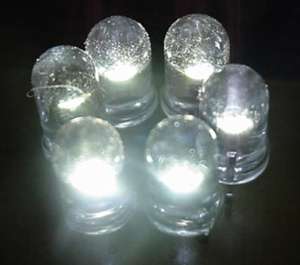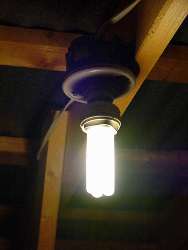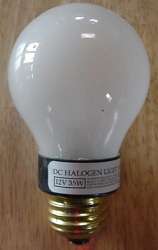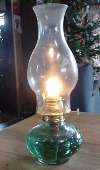Incandescent lights are basically electric space heaters that give off light as a byproduct. They are VERY inefficient, wasting most of the power they consume as heat.
Since lights are one of the biggest power uses in a remote home, pay close attention to what kind you use. If you replace all of your lights with efficient versions, you may be able to get by with fewer expensive batteries and solar panels.
You may have noticed that we've made major changes to this page. This is because of new information given to us by some lighting experts regarding lighting efficiency. Our thanks to Don Klipstein and Victor Roberts for the engineering lessons... Otherpower.com's lighting recommendations in a nutshell: For best efficiency, use fluorescents of any type. Install standard fluorescents in workspaces where you can stand the blue-tinged light, hum and flicker. Use compact flourescents in living spaces for a more 'friendly' ambiance. Use halogen lighting for outdoor applications where temperature causes problems with fluorescents. Use white LED lighting for applications that normally use dismally-efficient small incandescents...task lights, nightlights, pathway lighting, exit signs, and flashlights. Don't use incandescent lighting at all if you can afford to avoid it. Lighting Efficiency Ratings A standard way of rating lighting efficiency is in lumens per watt--this figure accounts for all of the light produced by a bulb. This rating does not necessarily reflect how much usable light is is thrown on your work area. The reflector and fixture will have a large effect on this. So be sure to read our guidelines for each type of lighting discussed below--lights that show a lower efficiency may still save you energy depending on the application.Be aware of the different ways that lighting efficiency can be represented. For example, there's a big difference between two common LED manufacturer's efficiency specs -- some show only lumens per watt of light output, while others show lumens per watt used by the LED. The latter is useful information, a true efficiency rating. The former does not include power wasted as heat, and is useless for evaluating lighting in an off-grid home.
- 32 watt T8 fluorescent--85 to 95 lumens/watt
- standard F40T12 cool white fluorescent--60-65 lumens/watt
- compact fluorescents--low 30's to low 60's lumens per watt, usually 48-60
- UPDATE 2012 -- The newest white LEDs shipping from manufacturers in 2012 are approaching the efficiency of compact fluorescents, into the 50-60 lumens/watt range. At this time, however, there are no RE lighting products that use these new LEDs, and they remain extremely expensive. Manufacturer's research labs are also reporting new white LEDs that approach the 80+ lumens/watt of T8 fluorescents. However, these products are not shipping yet.
- T3 tubular halogen--20 lumens/watt
- white LED--15-19 lumens/watt
- standard 100 watt incandescent--17 lumens/watt
- incandescent night light bulb (7w)--6 lumens/watt
- incandescent flashlight bulbs--dismal, less than 6 lumens/watt
Don Klipstein's LED news page is an excellent place to keep track of the latest developments in LED technology.
 Groups of 3-9 white LEDs are effective as reading lamps. 3 of our white LEDs running together use only 0.22 watts! Single white LEDs make great pathway lights, and can be left on all the time. Flashlights can be easily converted to use LED bulbs...this is probably the best application for them. Converted LED flashlights have become my favorite lights for fire/rescue and wildland firefighting, since the batteries last 6 times longer, I've never replaced an LED bulb, and light output is more even, though slightly dimmer than the original.
These lights were a huge advance in energy efficient lighting--very efficient, with 10 times longer life than an incandescent bulb. Plus, the light quality (color temperature) is much warmer than normal fluorescents, they fit in most normal light fixtures, and flicker is hardly noticable. Models are available for any application, including spotlights with reflectors.
Groups of 3-9 white LEDs are effective as reading lamps. 3 of our white LEDs running together use only 0.22 watts! Single white LEDs make great pathway lights, and can be left on all the time. Flashlights can be easily converted to use LED bulbs...this is probably the best application for them. Converted LED flashlights have become my favorite lights for fire/rescue and wildland firefighting, since the batteries last 6 times longer, I've never replaced an LED bulb, and light output is more even, though slightly dimmer than the original.
These lights were a huge advance in energy efficient lighting--very efficient, with 10 times longer life than an incandescent bulb. Plus, the light quality (color temperature) is much warmer than normal fluorescents, they fit in most normal light fixtures, and flicker is hardly noticable. Models are available for any application, including spotlights with reflectors.
 We highly recommend these lights in both 120 volts AC and 12 volts DC models. The AC versions are available at any hardware store and are very inexpensive for efficient lights ($8 to $15 each). DC compact fluorescants are more expensive because of limited demand for 12 volt ballasts, but only the ballast is different for AC and DC compact fluorescents--the bulbs are the same! We may soon offer interchangable compact fluorescent bulbs and ballasts for both 12 volt DC and 120 volt AC systems. Currently, interchangable parts are available from various RE suppliers.
The only drawbacks to keep in mind for compact fluorescents are 1) they are not very bright at cold temperatures, and 2) the quality of light is still not as good as halogen or incandescent bulbs. I personally use 12 volt DC halogen bulbs for reading lights, while lighting whole rooms with compact fluorescents.
These really are a very good, energy efficient method of area lighting, and are widely available. They are the most efficient room light available. Problem is, the quality of light is very irritating to some people. It's too blue, and some of them flicker (depends on the ballast design), which is extremely annoying to me. Perhaps this is a reaction to my lifelong aversion to large office buildings with windows that don't open! But fluorescents make great energy efficient lights for shops, garages, etc. where you don't have to spend too much time in the winter. I also use them for under-cabinet countertop lights in the kitchen.
These bulbs are only about 15% more efficient than standard incandescents, but are available in 12 volt DC versions. They were a lifesaver for our house--the inverter doesn't have to run to use them, they are more efficient, and the quality of light is excellent for reading or any other use. They fit in ALL standard light sockets, so the monetary investment is low. AC versions are available anywhere, and are still more efficient than standard bulbs. They give out lots of light even in an outdoor situation where its 25 degrees below zero, and last almost 3 times longer than incandescants. We hope to offer 12 volt DC Halogen bulbs for sale on our products page soon, as they are difficult to find--even most RV shops don't carry them, only the innefficient 12 volt incandescents.
We highly recommend these lights in both 120 volts AC and 12 volts DC models. The AC versions are available at any hardware store and are very inexpensive for efficient lights ($8 to $15 each). DC compact fluorescants are more expensive because of limited demand for 12 volt ballasts, but only the ballast is different for AC and DC compact fluorescents--the bulbs are the same! We may soon offer interchangable compact fluorescent bulbs and ballasts for both 12 volt DC and 120 volt AC systems. Currently, interchangable parts are available from various RE suppliers.
The only drawbacks to keep in mind for compact fluorescents are 1) they are not very bright at cold temperatures, and 2) the quality of light is still not as good as halogen or incandescent bulbs. I personally use 12 volt DC halogen bulbs for reading lights, while lighting whole rooms with compact fluorescents.
These really are a very good, energy efficient method of area lighting, and are widely available. They are the most efficient room light available. Problem is, the quality of light is very irritating to some people. It's too blue, and some of them flicker (depends on the ballast design), which is extremely annoying to me. Perhaps this is a reaction to my lifelong aversion to large office buildings with windows that don't open! But fluorescents make great energy efficient lights for shops, garages, etc. where you don't have to spend too much time in the winter. I also use them for under-cabinet countertop lights in the kitchen.
These bulbs are only about 15% more efficient than standard incandescents, but are available in 12 volt DC versions. They were a lifesaver for our house--the inverter doesn't have to run to use them, they are more efficient, and the quality of light is excellent for reading or any other use. They fit in ALL standard light sockets, so the monetary investment is low. AC versions are available anywhere, and are still more efficient than standard bulbs. They give out lots of light even in an outdoor situation where its 25 degrees below zero, and last almost 3 times longer than incandescants. We hope to offer 12 volt DC Halogen bulbs for sale on our products page soon, as they are difficult to find--even most RV shops don't carry them, only the innefficient 12 volt incandescents.
 They give out more heat than light. Only 40 cents each, or lots more in 12 volt versions. Popular electricity wasters, seen in almost every grid-connected house. Edison's invention changed the world, but much more efficient lights are available now. Besides, EDISON HAD GRID POWER!
Amory Lovins of the Rocky Mountain Institute calculated that replacing a 75 watt incandescent lightbulb with an 18 watt compact flourescent (that gives the same amount of light) would, over the lifespan of the new bulb, prevent the emission of about 1 ton of carbon dioxide and 8 kilograms of sulpher dioxide into the atmosphere, plus a huge savings on electricity cost. And, the compact flourescent will last over 10 times as long.
Gas Lights
A real technological innovation a hundred years ago, these lights are still effective today if you have no electricity and some propane or gasline to burn. Humphrey has been making these lamps for 92 years, they are available from Jade Mountain, Lehmans, and certain Amish catalogs. They make some noise, but not too much.
Coleman lanterns are another familiar gas light--they use white gas that is vaporized in a heated generator tube. These are VERY noisy! Also, the mantles in these lights (and in kerosene mantle lamps) are treated with radioactive thorium--it doesn't pose much of a hazard, but don't carry mantles in your pocket! The thorium from lantern mantles can be used to contruct a home built lightning detector for fun or experiments--see our plans on this website.
The Aladdin mantle version of these (with the tall glass chimney) produces lots of light and heat, more than enough to read by. Regular kerosene lamps produce enough to read by, barely, but are much brighter than a candle. But most of us up here spent at least a year with ONLY kerosene for lighting, and it sure beats a candle or nothing! Be careful of the fire hazard--don't burn these lights unattended.
They give out more heat than light. Only 40 cents each, or lots more in 12 volt versions. Popular electricity wasters, seen in almost every grid-connected house. Edison's invention changed the world, but much more efficient lights are available now. Besides, EDISON HAD GRID POWER!
Amory Lovins of the Rocky Mountain Institute calculated that replacing a 75 watt incandescent lightbulb with an 18 watt compact flourescent (that gives the same amount of light) would, over the lifespan of the new bulb, prevent the emission of about 1 ton of carbon dioxide and 8 kilograms of sulpher dioxide into the atmosphere, plus a huge savings on electricity cost. And, the compact flourescent will last over 10 times as long.
Gas Lights
A real technological innovation a hundred years ago, these lights are still effective today if you have no electricity and some propane or gasline to burn. Humphrey has been making these lamps for 92 years, they are available from Jade Mountain, Lehmans, and certain Amish catalogs. They make some noise, but not too much.
Coleman lanterns are another familiar gas light--they use white gas that is vaporized in a heated generator tube. These are VERY noisy! Also, the mantles in these lights (and in kerosene mantle lamps) are treated with radioactive thorium--it doesn't pose much of a hazard, but don't carry mantles in your pocket! The thorium from lantern mantles can be used to contruct a home built lightning detector for fun or experiments--see our plans on this website.
The Aladdin mantle version of these (with the tall glass chimney) produces lots of light and heat, more than enough to read by. Regular kerosene lamps produce enough to read by, barely, but are much brighter than a candle. But most of us up here spent at least a year with ONLY kerosene for lighting, and it sure beats a candle or nothing! Be careful of the fire hazard--don't burn these lights unattended.
 Even off-grid systems can fail at the worst possible time, and the utility grid experiences frequent failures. It's very handy to have automatic emergency lighting near the critical areas of your home, especially the power control center. And in the USA, most businesses (no matter how small) are required to have emergency lighting systems so that people can safely exit the building during a blackout. There are various systems available that use self-contained batteries and efficient CF or LED lights, but batteries fail over time too. Recent technological developments have made Self-Luminous Emergency Lighting possible, with no batteries or electricity involved. Both versions of these lamps are very handy to have around, and have at least a 25 year life span.
Even off-grid systems can fail at the worst possible time, and the utility grid experiences frequent failures. It's very handy to have automatic emergency lighting near the critical areas of your home, especially the power control center. And in the USA, most businesses (no matter how small) are required to have emergency lighting systems so that people can safely exit the building during a blackout. There are various systems available that use self-contained batteries and efficient CF or LED lights, but batteries fail over time too. Recent technological developments have made Self-Luminous Emergency Lighting possible, with no batteries or electricity involved. Both versions of these lamps are very handy to have around, and have at least a 25 year life span.

